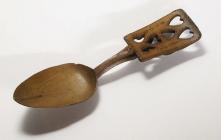Dwynwen, Patron Saint of Lovers
Items in this story:
Dwynwen's story
On 25 January the Welsh celebrate the day of Saint Dwynwen, their patron saint of love and friendship.
Iolo Morganwg told Dwynwen's story in the nineteenth century and this has become the basis for most modern tales of her life. She lived in the 5th century and was one of the most beautiful of Brychan's daughters. Dwynwen fell in love with Maelon Dafodrill but she had already been betrothed by her father to another prince, who didn't like Maelon. Maelon, was forced to leave and turned into a block of ice. Dwynwen fled to the forest where she prayed that God would release from her love for Maelon. She was granted three wishes by God and her first wish was that Maelon be thawed. Her second wish was that she might hear the hopes and prayers of lovers who needed assistance, and her final wish was to never marry.
Llanddwyn Island
To show her gratitude for having her wishes granted, she gave her life to the service of God and lived the rest of her life as a nun on the island of Llanddwyn off the coast of Anglesey. Llanddwyn became a destination for lovers searching for comfort and answers at Dwynwen’s fountain. The fountain is reputed to contain a sacred fish whose movements can foretell the future of lovers. According to legend, if bubbles appear on the surface of the water, luck the visitor will be blessed with luck and love.
One of Llanddwyn’s most famous visitors was the fourteenth century Welsh poet Dafydd ap Gwilym. He asked Dwynwen’s statue to be a messenger between him and Morfudd, the woman he wished to court, despite the fact that Morfudd was married!
January 25th
Today, Saint Dwynwen’s Day is celebrated in much the same way as St Valentine’s Day with cards and presents being exchanged between Welsh couples. The day can be seen as part of an unique tradition of love and courtship in Wales, along the same lines as the practice of carving lovespoons as a symbol of love.


